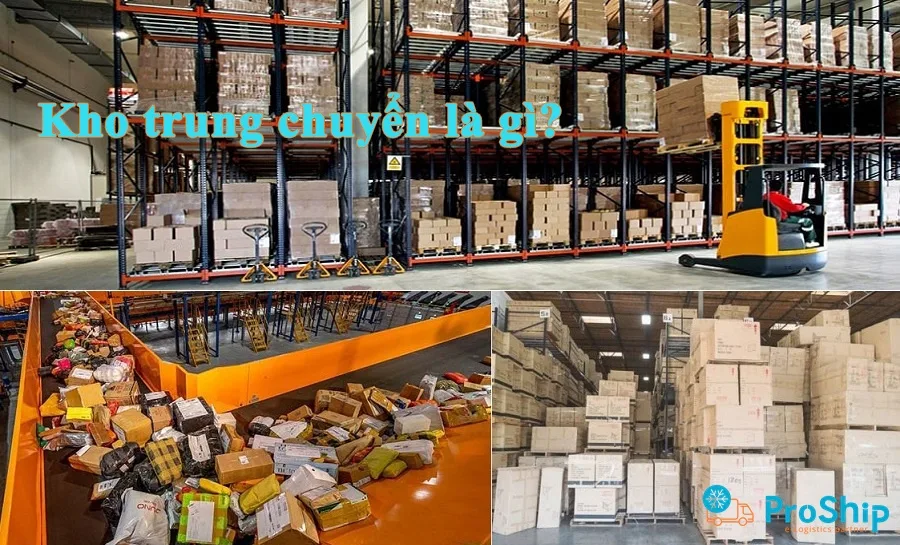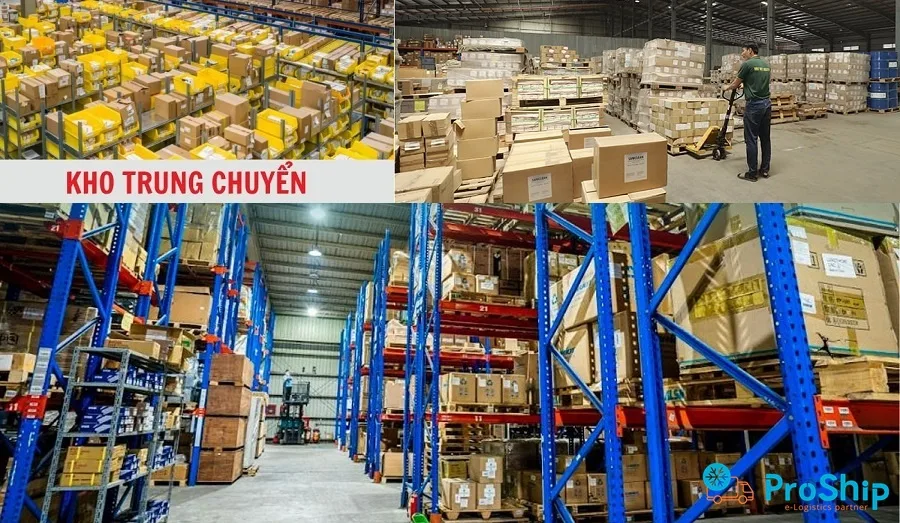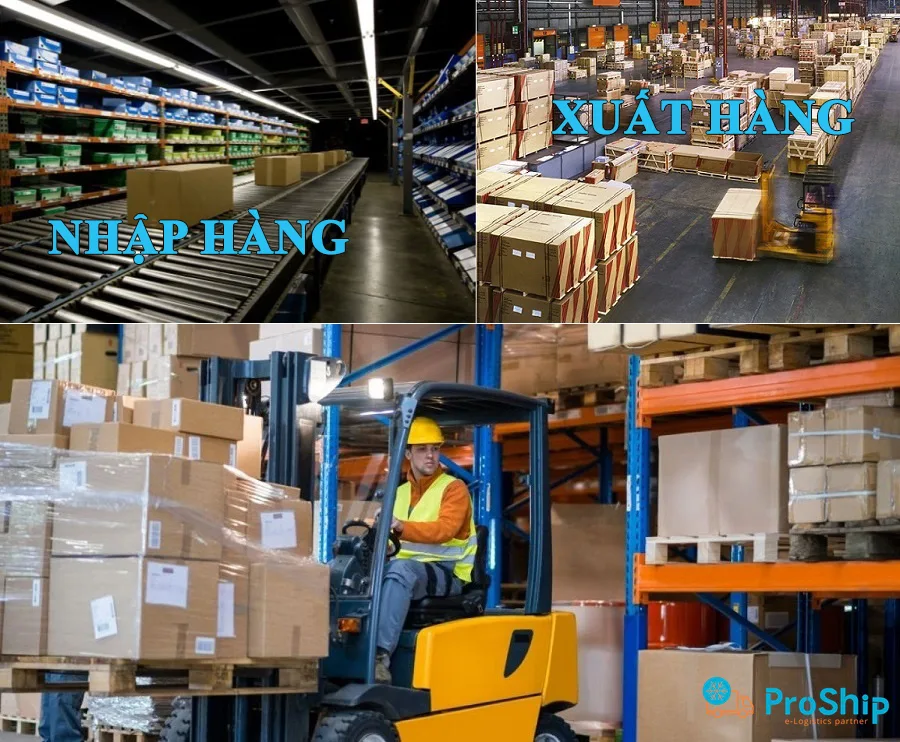x Doanh nghiệp, nhà bán lẻ, người mua hàng,…có lô hàng chuyển vào kho trung chuyển nhưng chưa biết đây là kho gì?
x Bạn muốn biết tác dụng, lợi ích của kho trung chuyển là gì, có quy định gì khi sử dụng kho không?
x Bạn cần tìm hiểu quy trình nhập hàng vào kho và xuất hàng từ kho trung chuyển ra như thế nào?
Proship.vn chúng tôi sẽ giải đáp tất tần tật kiến thức cần biết về kho trung chuyển là gì, có tác dụng gì với việc vận chuyển và xuất nhập hàng hóa, quy trình nhập/xuất hàng ra sao,…để các chủ hàng, doanh nghiệp nắm bắt kịp thời và chọn được loại kho lưu trữ hàng tương thích.
Kho trung chuyển là kho gì? Có quy định gì?
Định nghĩa kho trung chuyển
Kho trung chuyển hiện được sử dụng khá nhiều trong lĩnh vực logistics hiện nay. Tuy nhiên, đối với những người mới vào nghề thì khái niệm này còn khá mới mẻ.
Vậy, kho trung chuyển là gì? Kho trung chuyển là nơi tập kết hàng hóa và lưu trữ hàng tạm thời cho các doanh nghiệp và chủ hàng lẻ, trước khi chuyển giao cho người mua. Kho trung chuyển cũng như các kho hàng thông thường nhưng mức độ ra vào hàng hóa nhanh hơn.
Kho trung chuyển được xem như mắc xích quan trọng trong quá trình vận chuyển hàng hóa. Khác với các kho hàng thông thường, kho trung chuyển giúp lưu trữ hàng tạm thời, sau đó sẽ nhanh xuất kho và giao đến người nhận.

Quy định liên quan đến kho trung chuyển
Căn cứ theo Điều 28 Thông tư 23/2012/TT-BKHCN quy định về việc cách ly khi vận chuyển và lưu kho trung chuyển như sau:
Điều 28. Cách ly khi vận chuyển và lưu kho trung chuyển
1. Trong quá trình vận chuyển và lưu kho trung chuyển, kiện, côngtenơ chứa vật liệu phóng xạ phải được cách ly khỏi:
a) Vị trí có người và có phim ảnh chưa rửa tuân theo quy định tại các Khoản 4 và Khoản 5 Điều 4 Thông tư này;
b) Hàng hóa nguy hiểm khác: dễ cháy, dễ nổ, độc hại.
2. Kiện hoặc lô hàng thuộc hạng II-VÀNG, III-VÀNG không được để trong khoang hành khách trừ trường hợp khoang này được dành riêng cho người được phép đặc biệt đi kèm.
3. Đối với vận chuyển vật liệu phân hạch khi lưu kho, nhóm kiện hoặc côngtenơ có CSI vượt giá trị 50 phải được đặt cách nhau tối thiểu 6 (m).
4. Người vận chuyển phải chịu trách nhiệm bảo đảm sự cách ly cần thiết được duy trì trong suốt quá trình vận chuyển và lưu kho trung chuyển.
Ngoài ra, căn cứ Điều 35 Thông tư 23/2012/TT-BKHCN quy định về trách nhiệm của bên vận chuyển như sau:
Trách nhiệm của bên vận chuyển
1. Ngoài những quy định về vận tải hàng hóa hiện hành, bên vận chuyển chỉ được chấp nhận vận chuyển khi:
a) Có đầy đủ bản khai, giấy chứng nhận đã được cơ quan thẩm quyền phê duyệt, giấy phép vận chuyển theo quy định của pháp luật, huớng dẫn trong vận chuyển;
b) Kiểm tra cẩn thận kiện, lô hàng, côngtenơ khớp với bản khai và theo đúng quy định tại Thông tư này. Trường hợp phát hiện những điều không đúng thì có quyền từ chối vận chuyển, lập biên bản và sao gửi cho các bên hữu quan (bên gửi hàng, bên nhận hàng) và cơ quan thẩm quyền.
2. Bảo đảm an toàn bức xạ trong suốt quá trình vận chuyển, lưu kho trung chuyển, bao gồm cả việc ghi nhật ký đọc suất liều trong quá trình vận chuyển.
3. Thông báo cụ thể kế hoạch, lộ trình vận chuyển vật liệu phóng xạ cho Cục An toàn bức xạ và hạt nhân và Sở Khoa học và Công nghệ tại địa phương trên tuyến đường vận chuyển.
Tác dụng kho trung chuyển là gì?
Vậy, tác dụng của kho trung chuyển là gì? Kho trung chuyển mang lại sự tiện dụng tối đa cho người sử dụng dịch vụ. Các kho này đảm bảo tính sẵn sàng và lưu thông hàng hóa nhanh. Vai trò chính của kho trung chuyển là:
Lưu kho, bảo quản hàng hóa
Tương tự như các kho thường khác, kho trung chuyển cũng có chức năng lưu trữ hàng hóa theo các điều kiện tiêu chuẩn.

Tiết kiệm thời gian và chi phí
Kho trung chuyển nằm ở những vị trí trung tâm, giao lộ kết nối nên rất tiện cho quá trình lưu trữ, chờ làm thủ tục xuất nhập.
Dễ kiểm soát, gom hàng phân phối
Doanh nghiệp có thể sử dụng các kho trung chuyển để làm điểm tập kết, hợp nhất các luồng hàng từ nhiều nguồn khác nhau để đảm bảo chuỗi cung ứng sản xuất – kinh doanh.
>>Xem thêm: Kho bảo thuế là gì?
Các khái niệm liên quan đến kho trung chuyển
Một mô hình vận chuyển hàng hóa thông qua cảng trung chuyển, cảng feeder và kho trung chuyển. Dưới đây là mô tả cơ bản từng khái niệm:
- Hàng trung chuyển: Hàng hóa từ quốc gia xuất khẩu qua cửa khẩu và cảng Việt Nam, đến kho trung chuyển và đến tay người tiêu dùng cuối.
- Cảng Feeder (Feeder Port): Cảng nhỏ đưa hàng lên tàu feeder trước khi chuyển đến cảng trung chuyển.
- Cảng trung chuyển (Hub Port): Cảng lớn, tập trung hàng từ các cảng feeder nhỏ, kết nối hệ thống vận chuyển.
Lưu ý về quy trình nhập xuất kho trung chuyển
Kho trung chuyển với quy trình nhập hàng và xuất hàng thế nào sẽ được Proship Logistics chia sẻ như sau:
Quy trình nhập hàng vào kho trung chuyển
Người sử dụng dịch vụ cần ký kết hợp đồng xác nhận với đơn vị cung cấp dịch vụ kho trung chuyển trước khi tiến hành đưa hàng vào kho. Hợp đồng này sẽ xác nhận các yếu tố cơ bản về hàng hoá khi nhập kho trung chuyển gồm: Thông tin về loại hàng lưu trữ, diện tích lưu trữ, quy trình khai thác/vận hành và các yêu cầu có liên quan khác.
Trước khi đưa hàng nhập vào kho trung chuyển, người sử dụng dịch vụ cần cung cấp kế hoạch vận chuyển hàng chi tiết để bộ phận quản lý kho xác nhận và chuẩn bị các phương án hậu cần đi kèm. Các thông tin chi tiết cần gửi khi hàng nhập kho trung chuyển bao gồm: thông tin hàng, số lượng, ngày dự kiến nhập kho, phương tiện vận tải,…
Sau khi hàng đến kho trung chuyển, hai bên cung cấp và sử dụng dịch vụ sẽ tiến hành kiểm tra, đối chiếu và xác nhận trước khi chính thức nhập kho hàng hóa.

Quy trình xuất hàng ra kho trung chuyển
Cũng như quá trình nhập kho, khi tiến hành xuất hàng ra khỏi kho trung chuyển, người sử dụng dịch vụ cũng cần cung cấp kế hoạch xuất hàng chi tiết. Các thông tin xuất hàng cần cung cấp gồm: Thông tin hàng, số lượng xuất, ngày xuất, phương tiện vận chuyển,…
Sau khi nhận được kế hoạch xuất hàng, đơn vị cung cấp dịch vụ kho trung chuyển sẽ tiến hành khai thác/vận hành thích hợp. Trước khi hàng hóa xuất khỏi kho trung chuyển, hai bên sẽ kiểm đếm và ký biên bản xác nhận xuất kho và hoàn thành quy trình.
Kho trung chuyển là gì, tác dụng của loại kho trung chuyển và cần lưu ý gì khi nhập hàng vào kho và xuất hàng ra khỏi kho đã được Proship giải đáp. Các doanh nghiệp hoặc đơn vị bán lẻ nào có nhu cầu sử dụng kho này có thể tìm hiểu trước cách thức hoạt động của kho,…Và nếu có nhu cầu sử dụng dịch vụ vận tải Đa phương thức giá rẻ tại đây, liên hệ ngay 0909 344 247.

